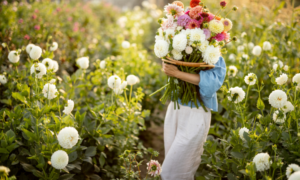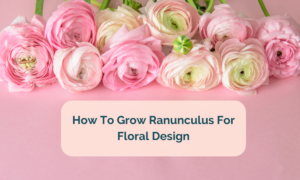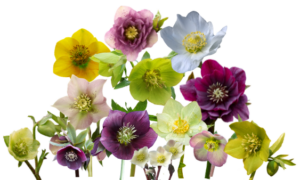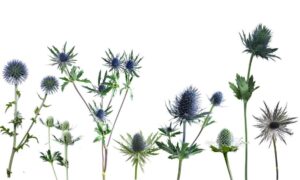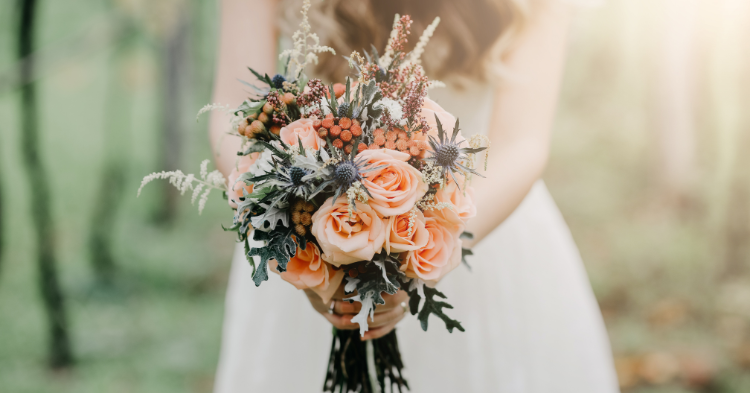Markups significantly impact florist profitability at any given time. There are additional factors to consider when enhancing profitability in your floral business. Are you a business owner in the floral industry seeking to boost your profit margins? This article will delve into three actionable methods to elevate your earnings on floral arrangements. Let’s delve deeper into how these strategies can assist you in refining your pricing structure and increasing profitability. Whether you’re operating from your kitchen, a home-based studio, renting a dedicated space, or running your own storefront as a florist.
The Markup On Floral Recipes Calculates The Florist Profitability
Typically, floral recipes encompass fresh flowers, hard goods, and occasionally rental items. When determining the appropriate markup, a key aspect of profitability involves considering how florists handle fresh florals, employing the correct processing techniques, and storing them at optimal temperatures before incorporating them into designs. Managing fresh flowers necessitates cool storage and skilled or trainee staff to clean and prepare them, constituting part of the labor costs.

Space considerations regarding containers, vases, and props available for rent must be considered.
Factors such as flowers, hard goods, rentals, and labor contribute to the overall markup, which varies among florists based on their specific requirements to cover expenses and attain a satisfactory take-home salary. Ultimately, the markup on floral arrangements dictates a florist’s profitability and bottom line.
Markup serves to cover the wholesale cost of products. However, it doesn’t inherently ensure profitability. Many florists miss out on potential profit by neglecting to apply markup to all items utilized in floral arrangements.
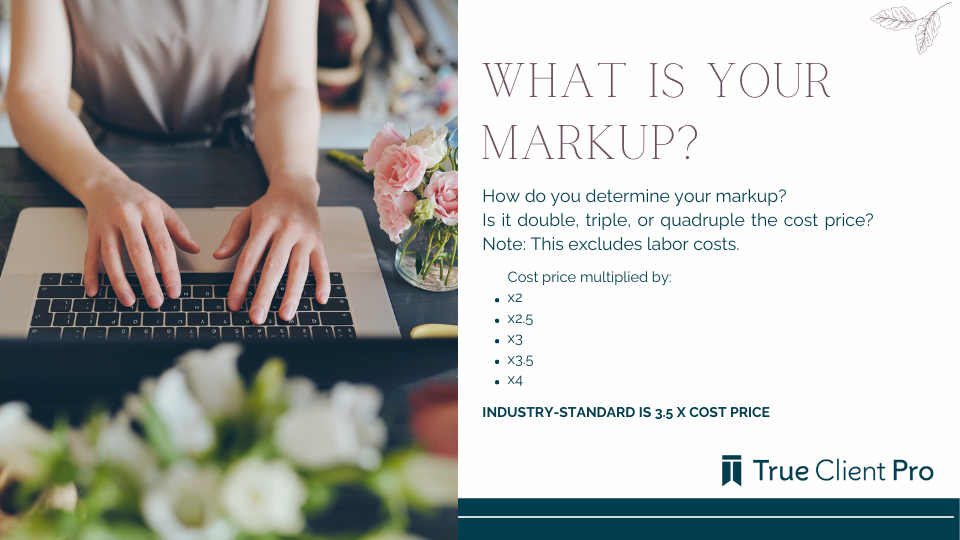
Flower Markup For Event And Retail Is 3.5 Times or 350% To Achieve Florist Profitability
To ensure profitability for fresh floral arrangements, apply a minimum markup of 3.5x (350%) to all your florals. Here’s an example:
Let’s say you purchased roses wholesale at $1 each. Apply a markup of 3.5x (350%). This means you will sell the roses at $3.5 each. Due to their perishable nature, fresh flowers are typically marked at higher prices than hard goods.
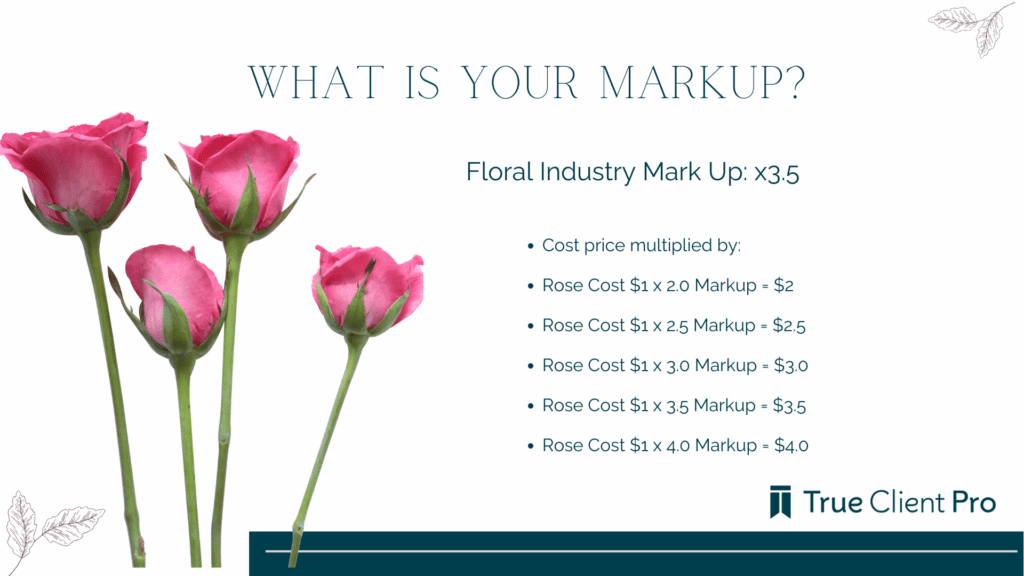
Fresh flowers are live products with a lifespan of 7-14 days. Caring for fresh flowers and greenery involves knowledge, water, a cooler, and more. If you’re learning how to care for your flowers or training your team members in your growing floral and event business, consider using True Client Pro to streamline the process and ensure consistency in flower processing instructions. Incorrect processing can lead to wilting flowers, necessitating replacements, and adding costs, ultimately reducing your profit margin.
Floral Industry Standard Practice Markup On Hardgoods Are 2.5x (250%) Ensuring Profitability.
Hard goods encompass containers, supplies, mechanics, packaging, and preparatory materials, all of which contribute to the hard goods markup when considering profitability.
Florists often work with hard goods purchased in bulk wholesale quantities. This entails factoring in time for unpacking, washing vases, recycling packaging materials, and storing unused items for events. After designing the floral arrangements, proper packing for transportation is necessary. Additionally, labeling, company logos, and branding expenses should be included in hard goods costs to ensure accurate pricing for profitability. Precision is essential in floral calculations, and Flower Math is seamlessly integrated into True Client Pro, a leading floral software that prioritizes florist profitability, automation, team communication, and more.
Markup Formula For Rental Items In Floral And Event Design
Most florists end up adding rental items in their business, whether by choice or needed to service a client, and in some cases, the client gifts them items that they bought, which become the florist’s rental items. When a florist has a rental item, the florist should consider the space it takes up and the maintenance you need to keep the purchased items.
The Formula For Pricing Rental Items Upon Purchase
When acquiring rental items, apply a markup of 2.5 times or 250% of the item’s acquisition cost. For instance, if you purchased a custom wooden arbor for a wedding ceremony for $300, the calculation would be $300 * 2.5x = $750. This cost solely covers the structure, which can already be significant. Additional flowers, labor, or mechanics expenses need to be factored in. When procuring rental items, always apply this formula, perform the necessary calculations, and remember that markup contributes to profitability in floral arrangements.
Before determining a price, several factors need consideration:
- Will you retain the arbor? If so, charge the full amount of $750.
- Are you intending to keep the arbor?
- Do you have adequate space for storage?
- How likely are you to reuse the item?
- Will you need to rent storage space?
- Will you share ownership and split costs with a friend?
- Who will retain ownership?
- Are there maintenance requirements for purchased items used as rentals?
- Does transportation of the item require significant space?
- What is the expected lifespan of the purchased item used as a rental?
Once the florist decides to proceed, they can assess the frequency of use to determine repayment. Establishing rental prices for subsequent uses can help offset the initial investment:
- If rented for $250 per use, recouping the investment would take 750/250 = 3 times.
- If rented for $200 per use, it would take $750/200 = 3.75 (rounded to 4 times).
The initial investment is recovered after renting the arbor 3 to 4 times, and any subsequent rentals yield pure profit.
For efficient organization of product inventory and accurate recipe calculation, maintain a markup of 1x (100%) once the rental price is set. True Client Pro offers customizable inventory tracking with detailed features.
Consider Floral Studio or Storefront Costs for Florist Profitability
The costs associated with your floral studio or storefront significantly impact your business’s profit ratio and floral markup. Rent expenses should be factored into markup calculations when determining the overall profitability of your floral business.
Considerations include but not limited to:
- Home-based studio
- Local economic market
- Rented or shared studio space
- Geographic location
- Demographics
Strategically pricing fresh florals, containers, and rental items and incorporating additional amounts into marked-up prices ensures profitability, enabling your business to thrive year after year.
Time Is Money, Include Time It Takes You To Design Floral Arrangements
To ensure florist profitability, many florists and designers calculate labor using a percentage in floral arrangements rather than an hourly pay rate. They typically deduct 20% of the labor from the retail cost of an item, allowing them to calculate flowers and hard goods for profitability. However, some florists opt for hourly rates. Using hourly rates as a flat rate may result in the floral business owner losing profit due to additional expenses such as payroll taxes and employee insurance.
Include Head Floral Designer Cost In Floral Recipes
The head floral designer possesses valuable skills and expertise earned through years of education and experience in floristry. Depending on the location, they may charge anywhere from $50 to $75 per hour.
Add Floral Designer Time to Each Floral Arrangement
Often, business owners themselves serve as head designers or floral designers, typically earning a slightly lower pay rate than a head floral designer. However, many creative florists underpay themselves, undervaluing their time and expertise.
Do not underestimate the importance of Designer’s Assistance Time
Compensate floral assistants at a rate higher than the minimum wage, considering their knowledge and experience in working with flowers or within the industry.
Floral Freelancer Cost By The Hour Or By The Day Rate
Experienced florists who prefer to work for other florists rather than owning their own business are freelancers. Typically, they receive compensation at the rate of a floral designer or head floral designer.
Event Help All Hours Throughout the Event Pull List, Pre-List Is A Must
Compensate any team or staff member assisting during an event at the going rate of the city or town. Alternatively, adjust their pay rate based on assigned tasks, such as heavy lifting or ladder climbing.
Accounting for labor when calculating pricing is crucial. Ensure you consider the time required to create each floral arrangement, whether done personally or by hiring a floral designer or freelancer. This method guarantees fair compensation for time and expertise, leading to more accurate pricing.
Consider your education and expertise when setting your pricing. Communicate your skills and qualifications as a floral designer to clients to justify your pricing and establish trust and reliability.
Event Set-Up and Strike-Down: Are They Markups or Fees? Do You Make Profit On It?
Every floral arrangement encompasses various sizes, time requirements, and labor. To ensure profitability, it’s essential to factor in design, set-up, and strike-down fees in your pricing structure. Begin by estimating the time required for each aspect of the event, from loading and transportation to site set-up and dismantling. This includes the time spent on design and flower processing. By meticulously accounting for these elements, you can accurately determine costs and profits, considering floral mark-ups, labor, and all associated expenses.

These additional charges encompass the creative process, design consultations, as well as the time and effort invested in setting up and dismantling arrangements. By incorporating these fees, you can maintain the sustainability and florist profitability of your business.
Maximize Your Florist Profitability, Include Everystem And Item In The Floral Recipe With Floral Industry Markup
crafting floral recipes extends beyond aesthetics; it’s also about cultivating a profitable business. If your focus remains solely on creativity and visual allure, it resembles more of a hobby than a business pursuit.
When integrating hard goods such as containers, baskets, vases, and urns into your designs, it’s essential to account for the associated mechanics’ costs. Overlooking these expenses in your pricing strategy can lead to inadequate profit margins on your floral arrangements.
Commonly overlooked hard goods items in floral arrangements include pins, ribbons, tape, chicken wire, water usage, and zip ties. While neglecting to fully consider these items may not immediately impact the profitability of individual projects, it can significantly affect overall business profits over time. In the floral industry, profitability can soar as high as 70%.
To ensure profitability and avoid unnecessary costs, meticulously include all expenses in your pricing calculations. This practice fosters a more successful floral business.
By adopting three key tactics — refining your pricing model, factoring in labor and material costs, demonstrating expertise, and incorporating design and setup charges — you can elevate the profitability of your floral arrangements and propel your floral enterprise toward success.
Are you eager to enhance your florist profitability? Embrace these strategies today and witness a notable upswing in profitability. Seize the opportunity to expand your business and achieve your financial goals. Begin your journey with True Client Pro’s complimentary trial, utilizing our advanced floral recipe functionalities, extensive floral database, and comprehensive production reports. These reports include detailed worksheets for floral designers, offering arrangement specifics, instructions, and more.

